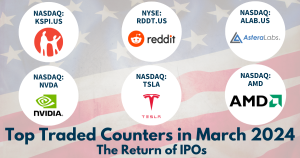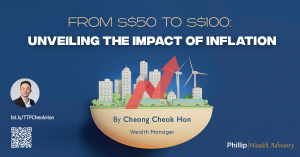A Look Back On 5 Equity Markets amidst COVID-19 March 30, 2020

The year 2019 saw a global meltdown with financial markets and investors suffering a turmoil. Economies and investors had struggled to recover from a major S&P sell-off that began in October 2018 and fell a whopping 15% at the end of 2018. 2019 was also marred with the on-going trade war between the U.S. and China, causing uncertainties and volatility worldwide. However, uncertainties also bring about opportunities. One example is S&P 500 and NASDAQ, where both Composite Indexes ended 2019 with nearly 40% up and hitting all time high records individually. The Financial Market in Asia also had a fantastic run in 2019 with the Shenzhen Composite Index leading the global markets table with the highest return within that year.
As we celebrate a fantastic run in 2019, let us look back at how some of the major equities markets have been faring thus far amidst the COVID-19 situation.
Table of Global Stock Market Indices that are tradable with POEMS:
| NAME | Last Price in 2019 | 1 Yr Total return (%) | P/E | Dividend Yield (%) | 5Yr Total Return (%) |
|---|---|---|---|---|---|
| NASDAQ COMPOSITE INDEX | 8972.604 | 36.74 | 32.99 | 1.12 | 101.22 |
| SHENZHEN SE COMPOSITE IX | 1722.945 | 35.91 | 37.39 | 1.02 | 13.49 |
| TAIWAN TAIEX INDEX | 11997.14 | 31.50 | 17.90 | 4.02 | 66.17 |
| S&P 500 INDEX | 3230.78 | 31.48 | 19.64 | 2.03 | 73.80 |
| S&P/TSX COMPOSITE INDEX | 17063.43 | 28.95 | 16.83 | 3.12 | 21.29 |
| Euro Stoxx 50 Pr | 3745.15 | 26.84 | 17.73 | 3.65 | 31.69 |
| DOW JONES INDUS. AVG | 28538.44 | 25.34 | 18.25 | 2.51 | 80.84 |
| S&P/ASX 200 INDEX | 6684.075 | 24.65 | 19.46 | 4.39 | 42.00 |
| SHANGHAI SE COMPOSITE | 3050.124 | 23.76 | 13.86 | 2.31 | -6.64 |
| DAX INDEX | 13249.01 | 22.95 | 20.61 | 3.32 | 24.60 |
| NIKKEI 225 | 23656.62 | 22.41 | 18.65 | 2.16 | 63.80 |
| FTSE 100 INDEX | 7542.44 | 21.98 | 19.35 | 5.31 | 19.79 |
| BIST 100 INDEX | 114425 | 15.90 | 8.31 | 3.54 | -37.73 |
| HANG SENG INDEX | 28189.75 | 13.64 | 10.79 | 3.79 | 42.43 |
| STOCK EXCH OF THAI INDEX | 1579.84 | 13.26 | 15.60 | 3.89 | 35.68 |
| Straits Times Index STI | 3222.83 | 10.88 | 11.07 | 4.23 | 13.15 |
| PSEi – PHILIPPINE SE IDX | 7815.26 | 10.00 | 14.84 | 1.83 | 3.57 |
| HO CHI MINH STOCK INDEX | 960.99 | 9.88 | 13.73 | 2.26 | 86.32 |
| JAKARTA COMPOSITE INDEX | 6299.539 | 8.71 | 16.52 | 2.86 | 19.38 |
| KOSPI INDEX | 2197.67 | 5.78 | 17.66 | 2.09 | 19.41 |
| FTSE Bursa Malaysia KLCI | 1588.76 | -1.80 | 16.60 | 3.75 | -9.50 |
| Average | 19.94 | 17.99 | 3.01 | 33.56 |
Period for Total return 1 year, P/E, Dividend is from 1 Jan 2019 to 31 Dec 2019 – quoted in USD
China: Shenzhen Stock Exchange Composite Index (2nd Position), Shanghai Composite Index (9th position)
2019 was a roller coaster ride for the Chinese market as both major indexes in Shanghai and Shenzhen had taken a major dive of 24.6% and 33.25% respectively back in 2018. One major contributing factor was the ongoing trade war with the U.S. China, however, made a remarkable recovery from what was their worst performing year in a decade by the end of 2019. The Shenzhen Composite Index was crowned the best performer with a 1 year return of 32.61%, closing at 1722.945 points.
The Shanghai Composite Index had also concurrently recovered by the end of 2019, ranking at the 11th position as top performing markets with a positive 1 year return of 13.74%. Ongoing talks, negotiations and a phase one deal between the U.S. and China helped to refuel investors’ confidence in the two largest economies in the world. The Chinese government helped to stabilise the overall financial markets by lifting its budget deficit target to 2.8% and introducing tax cuts for both businesses and individuals at the same time. This move helped to neutralise the deleveraging campaign sought by the Chinese government in 2018.
However, at the start of 2020, China was suddenly plagued by the new strain of novel coronavirus (COVID-19), emerging from the city of Wuhan, Hubei Province. This epidemic has thus far affected numerous big industries such as retail, food production, manufacturing, tourism and supply chains. The airline industry especially suffered with a sharp decline in passenger traffic by an average of 4.3%5 as a result of cancelled flights and closure of airports. Thankfully, as evident by past epidemics – mainly the H1N1 and SARS episodes, a recovery can be seen on most of the affected industries. While investors look towards defensive sectors to weather through the unknown(s), we have listed the bigger market-cap leaders in China for investors who are still looking to gain exposure into the Chinese market.
| Name | Ticker | Price (CNY) | Mkt Cap (USD) | P/E Ratio | Analyst Recommendation |
Consensus Target Price (CNY) |
|---|---|---|---|---|---|---|
| Ping An Insurance Group | 601318 | 77.92 | 213.13b | 9.26 | 97.0% Buy 3.0% Hold |
104.66 |
| Kweichow Moutai Co. | 600519 | 1066.03 | 173.08b | 33.39 | 90.9% Buy 4.5% Hold |
1254.36 |
| Bank of China | 601988 | 3.57 | 143.02b | 4 | 57.7% Buy 30.8% Hold |
4.04 |
| Industrial and Commercial Bank of China | 601398 | 5.32 | 265.97 b | 6.26 | 80% Buy 17.1% Hold |
6.80 |
(Source: Bloomberg)
Info accurate as of 28/2/2020
Taiwan: TAIWAN TAIEX INDEX (3rd position)
Apart from China, Taiwan Manufacturing Purchasing Managers’ Index (PMI) whom had gone through periods of contraction was also greatly affected by the tariffs war between US-China. But as the trade war situation de-escalated, Taiwan’s economy went through a cyclical recovery in 2019, with its PMI crossing above 50 in December 2019.1
Amongst all, retail food industry revenue hit multiple record highs despite a decline in the wholesale industry. This has caused the real private consumption growth to remain at 1.99% in 2019 for the first 10 months in FY 2019. Foreign trades with exports on domestic and technology products grew in the 3rd quarter of 2019 whilst imports reduced. Nevertheless, both import and export of goods are projected to grow by 2.56% and 2.52%, respectively, in 2020.2
Taiwan’s average GDP growth has maintained at around 2.6% for FY2018 and an average of 2.41% over the past 5 years.3 It is the seventh largest in Asia and 22nd-largest by purchasing power parity (PPP). 4 According to the forecast in FY2019, Taiwanese economic growth was expected to be 2.62%5 and this momentum of expansion is expected to continue in 2020, upwards of 2% as projected by the World Bank and International Monetary Fund (IMF). 6 Forecast done by Focus Economics panelists also projected GDP growth of 2.3% and 2.2% in 2020 and 2021 respectively. 7 Right after the presidential election in January 2020 – Tsai Ing-Wen retained her presidency and majority of her party remained in legislature – a continuation of current pro-growth economic policies will likely happen.
The total return for the Taiwan stock exchange weighted index (TWSE) in 2019 stands at 31.50%, making it the 3rd highest among others. Its has a 5-year annualised total return of 66.17%. Dividend return was promising as well at 4.02%, ranking 4th as compared to the indices average of 3.01%. Taiwan, being a developed market, is bound to encounter some major long-term challenges affected by diplomatic isolation and increasing competition from China and other Asia Pacific markets.
For investors who wish to gain exposure to the Taiwan market, below is a list of big-cap Taiwan stocks that are considered market leaders in their respective business segments.
| Name | Ticker | Price (TWD) | Mkt Cap (USD) | PE Ratio | Analyst Recommendation |
Consensus Target Price (TWD) |
|---|---|---|---|---|---|---|
| Chunghwa Telecom | 2412 | 108 | 27.6b | 25.58 | 56.3% Hold 43.8% Sells |
92.69 |
| Hotai Motor | 2207 | 627 | 11.3b | 30.55 | 100% Buy | 730 |
| Uni-President | 1216 | 73.20 | 13.7b | 22.02 | 50% Buy 50% Hold |
80.57 |
| Taiwan High Speed Rail | 2633 | 34.50 | 6.4b | 24.20 | 50% Buy 50% Hold |
42 |
| TSMC | 2330 | 316 | 270b | 23.73 | 84.4% Buy 9.4% Hold |
371.54 |
| Formosa Plastics | 1301 | 91 | 19.1b | 15.57 | 68.4% Buy 31.6% Hold |
108.30 |
(Source: Bloomberg)
Info accurate as of 28/2/2020
United States: NASDAQ, S&P 500 and Dow Jones (1st, 4th and 7th position)
2019 was a year for the technology sector in the U.S. market to soar as the Nasdaq Composite index tilted heavily towards technology related stocks. NASDAQ was among the top 3 best performing indexes with 27.23% return in 2019. In fact by looking at the 5-year returns of 107.33%, NASDAQ Composite Index was crowned the top performer on the list. The other 2 major U.S .indexes, S&P 500 and Dow Jones Industrial Averages came in at 4th and 8th positions respectively with 22.73% and 16.86% returns in 2019.
Interest rates were however cut in 2019, announced by the US Federal Reserve through three consecutive meetings in August, September and October 2019. The year before, it was raised 4 times. The last consecutive rate cut was back in 1996 and 1998. The interest rate is now standing at 1.5%-1.75% and according to the statement released by FOMC, it is expected to stay constant through 2020.
Trade disputes and geopolitical tensions continued throughout 2019 but toned down as trade tension between the U.S. and China came to a phase one agreement nearing the end of 2019. The situation became a crisis after the Coronavirus Outbreak in Wuhan, China, potentially deemed as a black swan event to the world economy.
Inverted yield curve was one of the key events that impacted the market where volatility increased in 2019. According to Prof Campbell Harvey, the inventor of the inverted yield curve, inversion usually points to a downturn of about 6 to 18 months in the future and if the forecast is true, recession might happen in year 2020.
We currently see that most of the indicators and economics data are growing healthily and there is no sign of recession hitting as yet. Though the longest bull trend in history seems to be strongly intact still, risks mentioned above must not be overlooked. Investors who would like to ride towards the market trend can consider ETFs like QQQ.US, SPY.US & DIA.US which tracks the NASDAQ Composite, S&P 500 and Dow Jones indexes respectively. Investors may also look into companies producing hygienic products or medical related counters like JNJ.US and PG.US. To further avoid over exposure to market risk, investors may even look into precious metal ETFs like SGOL.US for gold and SIVR.US for silver to hedge away the risk. These two ETF’s expense ratio were the lowest amongst all others precious metal ETFs.
Lastly, investors should avoid tourism related stocks at this moment.
A summary of the counters:
| Name | Ticker | Price | Mkt Cap (USD) | Expense Ratio / PE Ratio | Analyst Recommendation |
Consensus Target Price |
|---|---|---|---|---|---|---|
| Invesco QQQ Trust | QQQ | 205.64 | 96.06b | 0.2% | – | – |
| SPDR S&P 500 ETF | SPY | 296.26 | 319.52b | 0.095% | – | – |
| SPDR Dow Jones Industrial Average ETF | DIA | 254.56 | 23.05b | 0.17% | – | – |
| Johnson & Johnson | JNJ | 134.48 | 400b | 24.27 | 63.6% Buy 31.8% Hold |
160.35 |
| Procter & Gamble | PG | 113.23 | 306.6b | 25.46 | 46.2% Buy 42.3% Hold |
128.7 |
| Aberdeen Standard Physical Swiss Gold ETF0.3% | SGOL | 15.18 | 1.36b | 0.17% | – | – |
| Aberdeen Standard Physical Silver ETF | SIVR | 16.07 | 402.47m | 0.3% | – | – |
(Source: Bloomberg)
Info accurate as of 28/2/2020
Australia: ASX 200 Index (8th position)
Standing at the 8th position, ASX 200 index had achieved a total return of 24.65% in the previous year, accompanied by a 4.39% dividend. These numbers made ASX 200 the 2nd best dividend just behind FTSE 100 Index. Australian REIT shares form a large portion of dividend and below are the 3 REIT companies that top the list for its highest dividend yield. Among the top 10 dividend yield that has been declared, 7 are from REIT companies – each contributing gross dividend yields of at least 5%.
In terms of valuation, three are currently trading below the ASX200 Index’s P/E and price-to-book (P/B). But with healthy fundamentals, attractive relative valuations and a consistent history of dividends, Australian REIT shares are still worth considering.
| Name | Ticker | Price (AUD) | Mkt Cap (USD) | PE Ratio | Analyst Recommendation |
Consensus Target Price (AUD) |
|---|---|---|---|---|---|---|
| Unibail-Rodamco-Westfield | URW | 9.14 | 16.5b | – | 50% Buy 50% Hold |
11.59 |
| Vicinity Centres | VCX | 2.16 | 5.3b | 23.06 | 10% Buy 60% Hold |
2.44 |
| Scentre Group | SCG | 3.46 | 19.49b | 15.53 | 30% Buy 30% Hold |
3.82 |
(Source: Bloomberg)
Info accurate as of 28/2/2020
For investors looking for diversity, they may look at Exchange Traded Funds (ETFs) in the following table – all listed in ASX market. For VAN-AU PROP ETF (VAP), it has an Asset Under Management (AUM) size of 1.84 Billion and expense ratio of 0.23. The 3 stocks in the above table are among the top 9 holdings of VAP ETF.
| Ticker | Short Name | Price | 1 Yr Total return (%) | Total Return Yth (%) | Asset under management (AUD Billion) | EXPENSE RATIO | TRACKING ERROR | NAV TRACKING ERROR |
|---|---|---|---|---|---|---|---|---|
| VAP | VAN-AU PROP ETF | 98.28 | 18.94 | -0.94 | 1.84 | 0.23 | 3.28 | 1.38 |
| SLF | SPDR S&P/ASX 200 | 15.33 | 19.09 | -1.08 | 0.73 | 0.4 | 7.99 | 1.74 |
| DJRE | SPDR DJ GL RL ES | 25.82 | 18.20 | -0.51 | 0.4 | 0.5 | 5.11 | 0.10 |
| MVA | VANECK VECTORS A | 27.36 | 22.14 | -1.19 | 0.28 | 0.35 | 3.01 | 0.03 |
| RENT | AMP CAP GL PR SE | 3.32 | 25.55 | 1.36 | 0.028 | 0.99 | 9.95 | 6.61 |
(Source: Bloomberg)
Info accurate as of 28/2/2020
Hong Kong: Hang Seng Index (14th position)
Hong Kong has seen a tumultuous year due to an 11 month protest, stimulated by the introduction of the Fugitive Offenders amendment bill. It has resulted in a violent anti-government demonstrations between protestors and the police. The protests also led to steep declines in tourism and retail sales, leading to the fall in GDP and the technical recession. Above all, Hong Kong’s year-on-year Gross Domestic Product (GDP) is declining and in Q3 of 2019, it entered into a technical recession of -2.9% GDP.
The stock market however has managed to recover thanks to the withdrawal of the amendment bill and trade deals between the US and China. Hong Kong is still seen as the top market for new listings with e-commerce giant Alibaba’s listing launched at 176 HKD per share, propelling it to become the world’s largest listing in 2019. HSI closed at the end of 2019 at 28189.75 points, with a positive return of 4.43% despite being it a tough year.
As one of the Four Asian Tigers and an international financial hub, Hong Kong still plays a big role in the stability and growth of the Asian financial markets. Despite a bleak start to 2020, we believe that Hong Kong will continue to be relevant in the global economy, maintaining its role as a financial leader in Asia and as China’s bridge to the World.
| Name | Ticker | Price (HKD) | Mkt Cap (USD) | P/E Ratio | Analyst Recommendation |
Consensus Target Price (HKD) |
|---|---|---|---|---|---|---|
| Alibaba | 9988 | 200.20 | 76.48b | 62.81 | 94.4% Buy 5.6% Hold |
255.46 |
| Tencent | 700 | 385.60 | 503.25b | 43.11 | 86.2% Buy 13.8% Hold |
431.80 |
| Bank of China | 3988 | 3.08 | 142.65b | 4.78 | 81.5% Buy 18.5% Hold |
4.10 |
| HSBC Holdings | 0005 | 53.05 | 151.33 | 10.81 | 28.6% Buy 31.3% Hold |
58.59 |
(Source: Bloomberg)
Info accurate as of 28/2/2020
Moving forward, investors have to keep a look out for the various on-going market moving events worldwide, especially the COVID-19 global epidemic that is currently affecting more than 29 countries. Clearly, we can see how the virus has affected the global economy since the virus swept across the globe in the first two months of 2020. There are no clear indications of its peak but no end appears to be in sight. However, historical data has shown that the global financial markets had in fact recovered after past few epidemics. As for now, we believe that the economies will recover, in hope for a reenactment the global markets had in 2019.
Reference:
[1] https://tradingeconomics.com/taiwan/manufacturing-pmi
[3] https://www.statista.com/statistics/727585/gross-domestic-product-gdp-growth-rate-in-taiwan/
[4] https://en.wikipedia.org/wiki/Economy_of_Taiwan and https://en.wikipedia.org/wiki/Purchasing_power_parity
[7] https://www.mckinsey.com/featured-insights/china/what-can-we-expect-in-china-in-2020
About the author
Global Markets Team
Phillip Global Markets offers you access to more than 23 global stock exchanges with just a single account. More information about our offerings.

 Back in Business: The Return of IPOs & Top Traded Counters in March 2024
Back in Business: The Return of IPOs & Top Traded Counters in March 2024  From $50 to $100: Unveiling the Impact of Inflation
From $50 to $100: Unveiling the Impact of Inflation  How to soar higher with Positive Carry!
How to soar higher with Positive Carry!  Why 2024 Offers A Small Window of Opportunity and How to Position Yourself to Capture It
Why 2024 Offers A Small Window of Opportunity and How to Position Yourself to Capture It 









